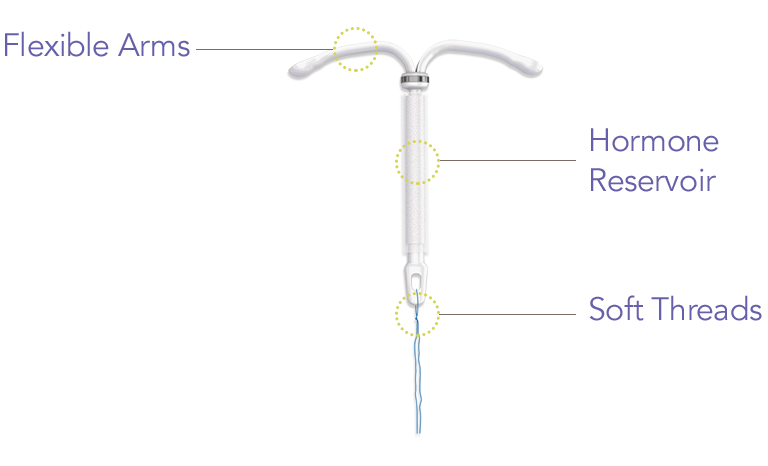
Kyleena is a pill-free birth control option
In a study of over 4,500 women around the world, including 500 women in the United States aged 21–29 years who take a daily birth control pill, 82% of US women reported* forgetting to take it at least once in the past 12 months.†
Kyleena lasts up to 5 years, and eliminates the responsibility of taking a daily pill—that’s 1,826 daily pills over 5 years vs 1 Kyleena IUD. Monthly pharmacy trips for birth control refills are a thing of the past! But, you will need to do a thread check once a month to make sure Kyleena is still in place. Your healthcare provider can show you how.
Within 4 to 6 weeks of placement, you should return for a follow-up visit. If you don't feel the threads or feel more than just the threads, call your healthcare provider. Kyleena may not be in the right position and may not prevent pregnancy. Avoid intercourse or use non-hormonal back-up birth control (such as condoms or spermicide) until your healthcare provider can check that Kyleena is still in the right place.
*When asked, "In the past 12 months, have you ever forgotten to take your pill?"
†Based on a study conducted by Opinion Health on behalf of Bayer Pharmaceuticals Division, conducted in June/July 2016.
Highly effective, low hormone 5-year IUD
-
Kyleena is over 99% effective at preventing pregnancy for each year of use, and 98.6% effective over 5 years
-
That means less than 1 pregnancy per 100 women in a year, and less than 2 pregnancies per 100 women over 5 years
-
-
T-shaped and made of soft, flexible plastic
-
Placed in your uterus by a healthcare provider, who can remove it at any time in case your plans change
-
Can be used whether or not you’ve had a baby

Common side effects during and after placement
You may experience pain, bleeding or dizziness during and after placement. If your symptoms do not pass within 30 minutes after placement, Kyleena may not have been placed correctly. Your healthcare provider will examine you to see if Kyleena needs to be removed or replaced.
If pain is a concern for you, ask your healthcare provider about taking over-the-counter pain medication before the procedure.
Click here for questions to ask your healthcare provider about IUD placement.
How small is Kyleena?

Reversible birth control on your terms
-
Placed in your uterus by your healthcare provider during a routine office visit
-
Can be removed by your healthcare provider at any time in case your plans change
Learn more about the pregnancy rates of your birth control options.

Some serious risk considerations about Kyleena
Although pregnancy while using Kyleena is uncommon (less than 1 in 100), it can be serious. Call your healthcare provider right away if you think you may be pregnant. If possible, also do a urine pregnancy test. If you get pregnant while using Kyleena, you may have an ectopic pregnancy. This means that the pregnancy is not in the uterus. Unusual vaginal bleeding or abdominal pain may be a sign of ectopic pregnancy. Ectopic pregnancy is a medical emergency that often requires surgery. Ectopic pregnancy can cause internal bleeding, infertility, and even death. There are also risks if you get pregnant while using Kyleena and the pregnancy is in the uterus. Severe infection, miscarriage, premature delivery, and even death can occur with pregnancies that continue with an intrauterine device (IUD). Because of this, your healthcare provider may try to remove Kyleena, even though removing it may cause a miscarriage. If Kyleena cannot be removed, talk with your healthcare provider about the benefits and risks of continuing the pregnancy and possible effects of the hormone on your unborn baby. If you continue your pregnancy, see your healthcare provider regularly. Call your healthcare provider right away if you get flu-like symptoms, fever, chills, cramping, pain, bleeding, vaginal discharge, or fluid leaking from your vagina. These may be signs of infection.
For a full list of serious risk considerations about Kyleena, please click here.
Explore more



INDICATION FOR KYLEENA
Kyleena® (levonorgestrel-releasing intrauterine system) is a hormone-releasing IUD that prevents pregnancy for up to 5 years.
IMPORTANT SAFETY INFORMATION
- If you have a pelvic or genital infection, get infections easily, or have certain cancers, don't use Kyleena. Less than 1% of users get a serious pelvic infection called pelvic inflammatory disease (PID).
- If you have persistent pelvic or stomach pain, or excessive bleeding after placement tell your healthcare provider (HCP). If Kyleena comes out, call your HCP and avoid intercourse or use non-hormonal back-up birth control (such as condoms or spermicide). Kyleena may go into or through the wall of the uterus and cause other problems.
- Pregnancy while using Kyleena is uncommon but can be life threatening and may result in loss of pregnancy or fertility.
- Ovarian cysts may occur but usually disappear.
- Bleeding and spotting may increase in the first 3 to 6 months and remain irregular. Periods over time usually become shorter, lighter, or may stop.
Kyleena does not protect against HIV or STIs.
Only you and your HCP can decide if Kyleena is right for you. Kyleena is available by prescription only.
For important risk and use information about Kyleena, please see Full Prescribing Information.
KYLEENA CO-PAY SAVINGS PROGRAM
SEE IF YOU’RE ELIGIBLE TO PAY AS LITTLE AS $20 OUT-OF-POCKET FOR KYLEENA*









